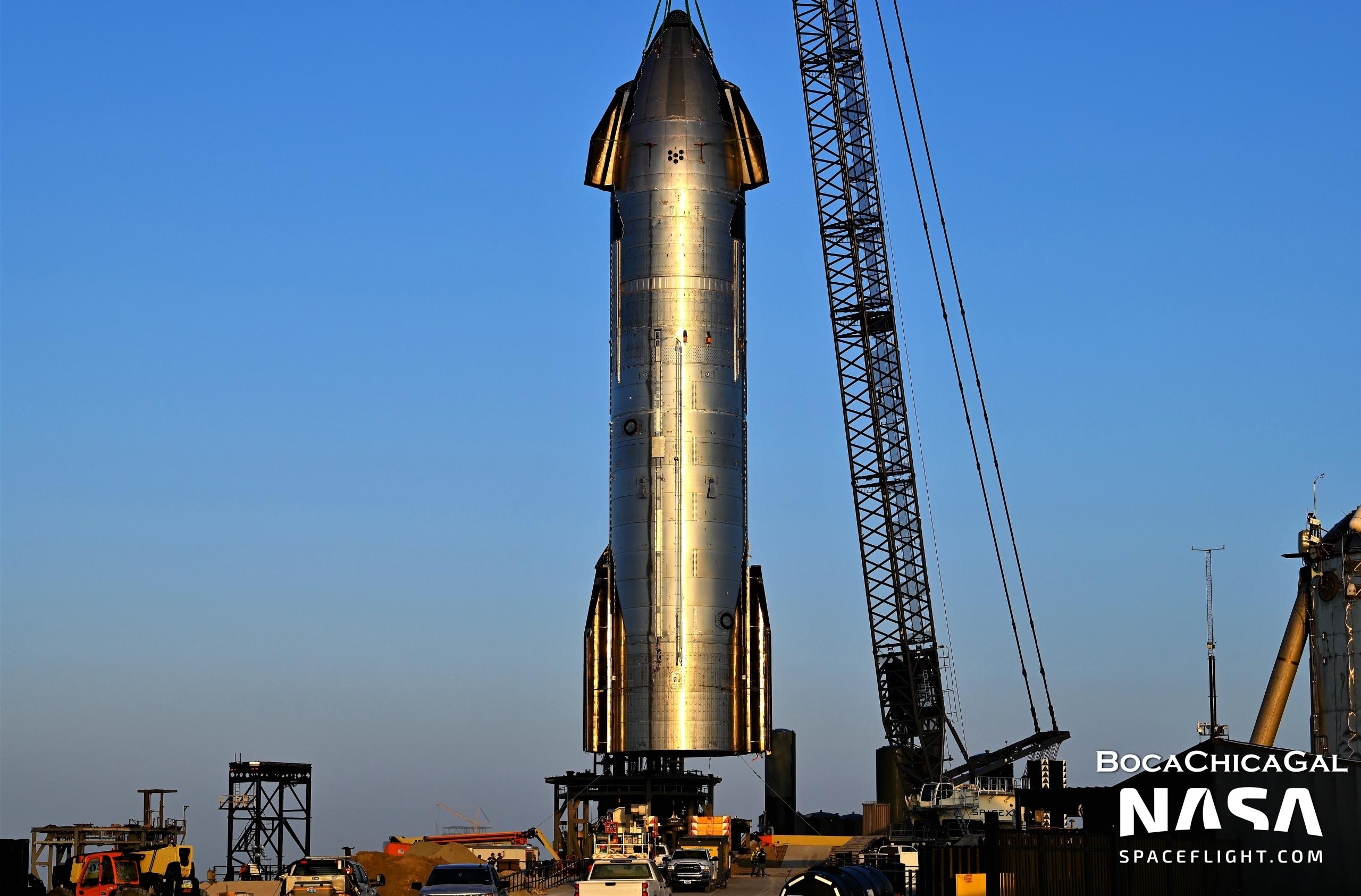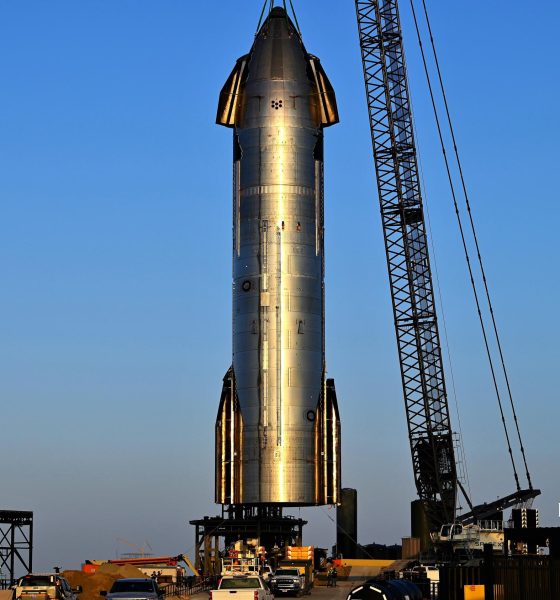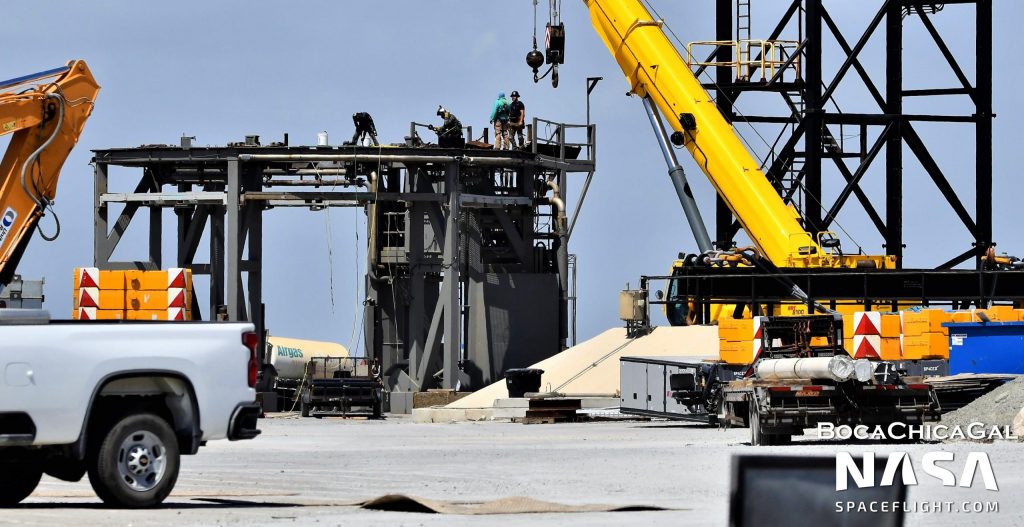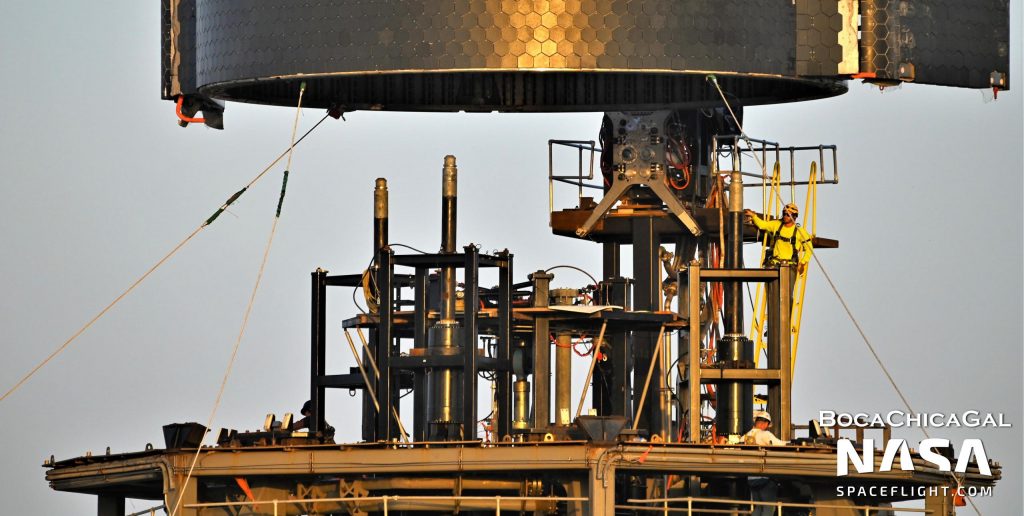

News
SpaceX Starship prototype returns to factory after simulated Raptor testing
A SpaceX Starship prototype that could become the first to launch into space has returned to the company’s Starbase rocket factory after completing a series of thorough proof tests.
Starship S24’s test campaign got off to a rough start when the roughly nine-meter (30 ft) wide, 50-meter (~165 ft) tall rocket blew a high-pressure pipe during its very first test – a generally benign ‘pneumatic proof.’ While it appears that most of the ship passed the test, the burst pipe damaged a section of the heat shield and took several days of continuous work to repair and replace. With that hiccup behind it, however, Ship 24 appears to have performed excellently during the next two phases.
On June 1st, the ship fully passed pneumatic proof testing on the second try. On June 2nd, it completed its first cryogenic proof test, referring to the process of filling and pressurizing Starship’s tanks with liquid nitrogen – ultra-cold like its methane and oxygen propellant but without the risk of fire or explosion. Once the basics were out of the way, Ship 24 was cleared for installation on one of two of SpaceX’s suborbital Starship test and launch pads. Over the course of about two months, Pad A was significantly modified both to support Ship 24’s upgraded design and to put it to the test by using giant hydraulic rams to simulate the thrust of Raptor engines.


Ship 24 was installed on the modified mount on June 4th, just 12 hours after completing its first cryoproof. On June 6th and 7th, SpaceX then put the prototype through another pair of cryogenic proof tests, both of which appeared to be completed without issue on the first try. The first test even saw Ship 24 use its nose vents, suggesting that SpaceX may have filled and pressurized both its main tanks and a smaller pair of landing propellant or ‘header’ tanks.
At some point during either or both of the Pad A cryoproofs, it’s believed that the mount’s hydraulic rams were used to test Ship 24’s upgraded aft end by simulating the thrust of six Raptor engines. Like Ship 20, Ship 24 will eventually be outfitted with three smaller sea level-optimized Raptors and three larger vacuum-optimized Raptors. However, Ship 24 will be the first Starship to use new Raptor 2 engines, which are capable of generating almost 25% more thrust. At full throttle, Ship 24 could theoretically produce almost 1400 tons (~3.1M lbf) of thrust at sea level, just shy of twice the thrust of an entire Falcon 9 booster. Starship will be the most powerful orbital spacecraft in history.
First, though, the rocket needs engines. After completing all three cryoproof tests without apparent issue, SpaceX removed Ship 24 from Pad A and transported it back to the Starbase factory on June 9th. While it’s not actually clear if those tests were fully successful, the general assumption is that SpaceX returned the prototype to the factory to fill gaps in its heat shield; complete its aerocovers and raceway; and, most importantly, install six Raptor 2 engines.
If that is the case, Ship 24’s second trip to the launch site could be for wet dress rehearsal and static fire testing – a campaign that could ultimately qualify the ship for Starship’s first orbital launch attempt.

News
Tesla FSD fleet is nearing 7 billion total miles, including 2.5 billion city miles
As can be seen on Tesla’s official FSD webpage, vehicles equipped with the system have now navigated over 6.99 billion miles.

Tesla’s Full Self-Driving (Supervised) fleet is closing in on almost 7 billion total miles driven, as per data posted by the company on its official FSD webpage.
These figures hint at the massive scale of data fueling Tesla’s rapid FSD improvements, which have been quite notable as of late.
FSD mileage milestones
As can be seen on Tesla’s official FSD webpage, vehicles equipped with the system have now navigated over 6.99 billion miles. Tesla owner and avid FSD tester Whole Mars Catalog also shared a screenshot indicating that from the nearly 7 billion miles traveled by the FSD fleet, more than 2.5 billion miles were driven inside cities.
City miles are particularly valuable for complex urban scenarios like unprotected turns, pedestrian interactions, and traffic lights. This is also the difference-maker for FSD, as only complex solutions, such as Waymo’s self-driving taxis, operate similarly on inner-city streets. And even then, incidents such as the San Francisco blackouts have proven challenging for sensor-rich vehicles like Waymos.
Tesla’s data edge
Tesla has a number of advantages in the autonomous vehicle sector, one of which is the size of its fleet and the number of vehicles training FSD on real-world roads. Tesla’s nearly 7 billion FSD miles then allow the company to roll out updates that make its vehicles behave like they are being driven by experienced drivers, even if they are operating on their own.
So notable are Tesla’s improvements to FSD that NVIDIA Director of Robotics Jim Fan, after experiencing FSD v14, noted that the system is the first AI that passes what he described as a “Physical Turing Test.”
“Despite knowing exactly how robot learning works, I still find it magical watching the steering wheel turn by itself. First it feels surreal, next it becomes routine. Then, like the smartphone, taking it away actively hurts. This is how humanity gets rewired and glued to god-like technologies,” Fan wrote in a post on X.
News
Tesla starts showing how FSD will change lives in Europe
Local officials tested the system on narrow country roads and were impressed by FSD’s smooth, human-like driving, with some calling the service a game-changer for everyday life in areas that are far from urban centers.

Tesla has launched Europe’s first public shuttle service using Full Self-Driving (Supervised) in the rural Eifelkreis Bitburg-Prüm region of Germany, demonstrating how the technology can restore independence and mobility for people who struggle with limited transport options.
Local officials tested the system on narrow country roads and were impressed by FSD’s smooth, human-like driving, with some calling the service a game-changer for everyday life in areas that are far from urban centers.
Officials see real impact on rural residents
Arzfeld Mayor Johannes Kuhl and District Administrator Andreas Kruppert personally tested the Tesla shuttle service. This allowed them to see just how well FSD navigated winding lanes and rural roads confidently. Kruppert said, “Autonomous driving sounds like science fiction to many, but we simply see here that it works totally well in rural regions too.” Kuhl, for his part, also noted that FSD “feels like a very experienced driver.”
The pilot complements the area’s “Citizen Bus” program, which provides on-demand rides for elderly residents who can no longer drive themselves. Tesla Europe shared a video of a demonstration of the service, highlighting how FSD gives people their freedom back, even in places where public transport is not as prevalent.
What the Ministry for Economic Affairs and Transport says
Rhineland-Palatinate’s Minister Daniela Schmitt supported the project, praising the collaboration that made this “first of its kind in Europe” possible. As per the ministry, the rural rollout for the service shows FSD’s potential beyond major cities, and it delivers tangible benefits like grocery runs, doctor visits, and social connections for isolated residents.
“Reliable and flexible mobility is especially vital in rural areas. With the launch of a shuttle service using self-driving vehicles (FSD supervised) by Tesla in the Eifelkreis Bitburg-Prüm, an innovative pilot project is now getting underway that complements local community bus services. It is the first project of its kind in Europe.
“The result is a real gain for rural mobility: greater accessibility, more flexibility and tangible benefits for everyday life. A strong signal for innovation, cooperation and future-oriented mobility beyond urban centers,” the ministry wrote in a LinkedIn post.
News
Tesla China quietly posts Robotaxi-related job listing
Tesla China is currently seeking a Low Voltage Electrical Engineer to work on circuit board design for the company’s autonomous vehicles.

Tesla has posted a new job listing in Shanghai explicitly tied to its Robotaxi program, fueling speculation that the company is preparing to launch its dedicated autonomous ride-hailing service in China.
As noted in the listing, Tesla China is currently seeking a Low Voltage Electrical Engineer to work on circuit board design for the company’s autonomous vehicles.
Robotaxi-specific role
The listing, which was shared on social media platform X by industry watcher @tslaming, suggested that Tesla China is looking to fill the role urgently. The job listing itself specifically mentions that the person hired for the role will be working on the Low Voltage Hardware team, which would design the circuit boards that would serve as the nervous system of the Robotaxi.
Key tasks for the role, as indicated in the job listing, include collaboration with PCB layout, firmware, mechanical, program management, and validation teams, among other responsibilities. The role is based in Shanghai.
China Robotaxi launch
China represents a massive potential market for robotaxis, with its dense urban centers and supportive policies in select cities. Tesla has limited permission to roll out FSD in the country, though despite this, its vehicles have been hailed as among the best in the market when it comes to autonomous features. So far, at least, it appears that China supports Tesla’s FSD and Robotaxi rollout.
This was hinted at in November, when Tesla brought the Cybercab to the 8th China International Import Expo (CIIE) in Shanghai, marking the first time that the autonomous two-seater was brought to the Asia-Pacific region. The vehicle, despite not having a release date in China, received a significant amount of interest among the event’s attendees.








